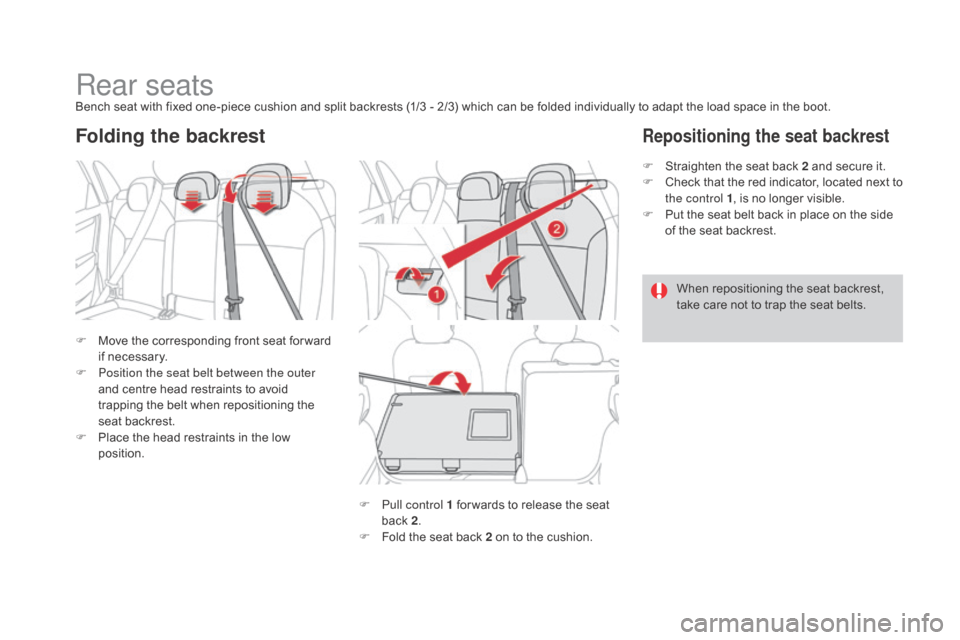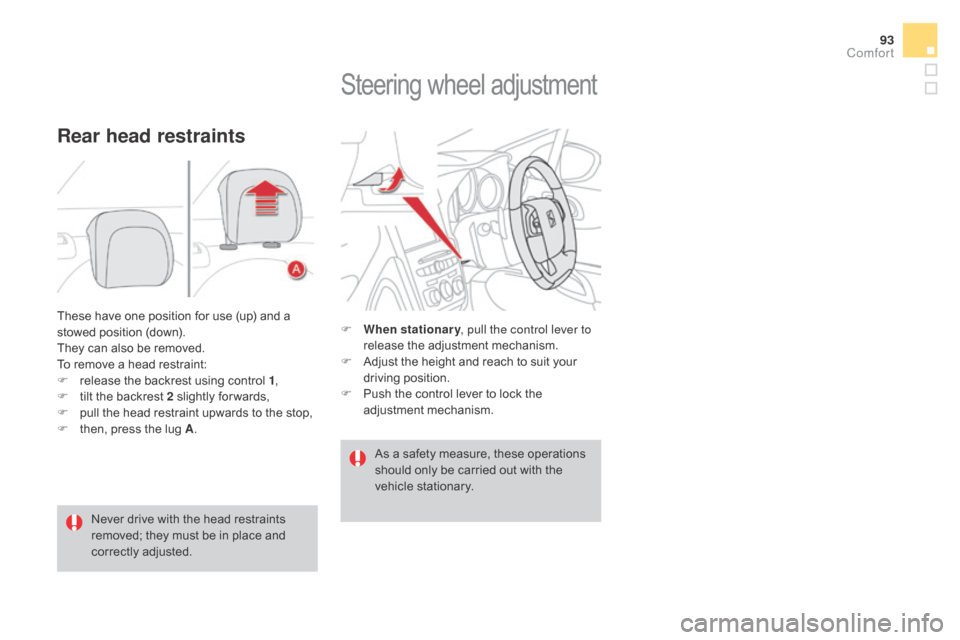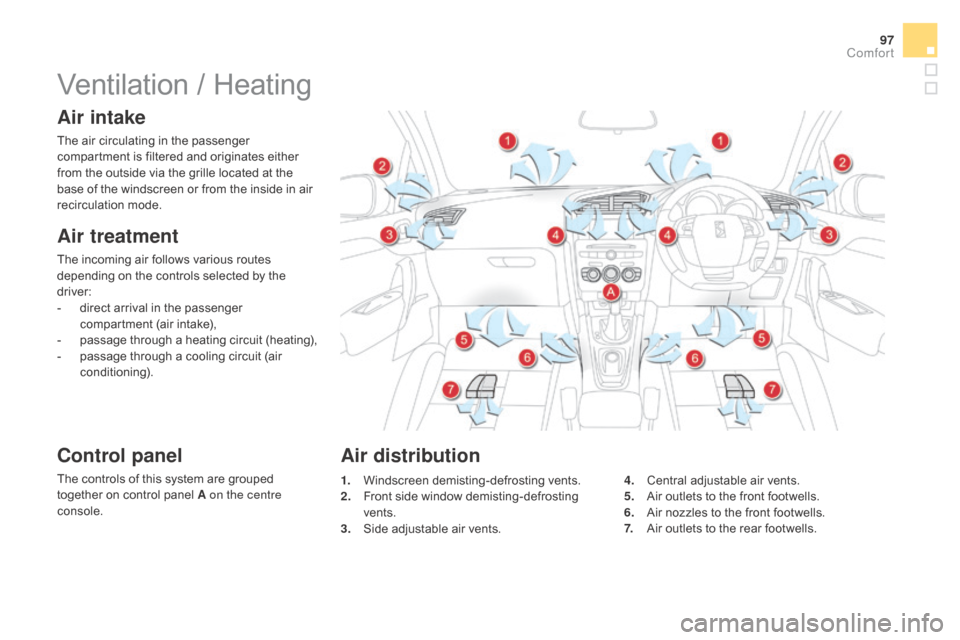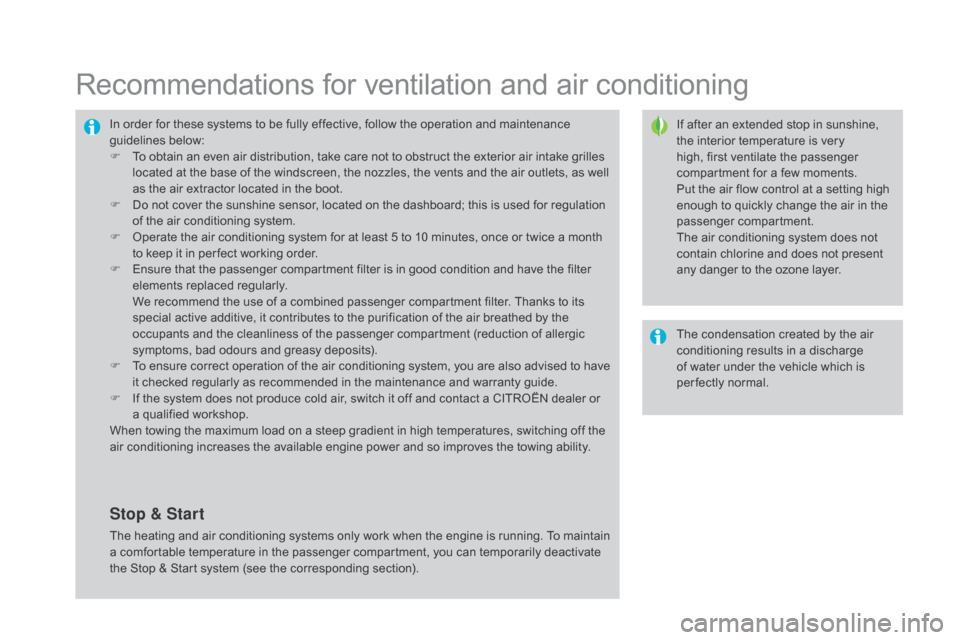Citroen DS4 RHD 2015.5 1.G Owners Manual
Manufacturer: CITROEN, Model Year: 2015.5, Model line: DS4 RHD, Model: Citroen DS4 RHD 2015.5 1.GPages: 436, PDF Size: 10.13 MB
Page 91 of 436

89
driver's seat electric
adjustments
Forwards-backwards
F Push the control for wards or rear wards to slide the seat.
Cushion height and angle
F Tilt the rear part of the control upwards or downwards to obtain the required height.
F
T
ilt the front part of the control upwards or
downwards to obtain the required angle.
Seat backrest angle
F Tilt the control for wards or rear wards to adjust the angle of the seat backrest.
The electrical functions of the driver's seat are deactivated approximately one minute after
the ignition is switched off.
To reactivate them, switch on the ignition.
Before moving the seat backwards, ensure that there is nothing that might prevent the full travel of the seat, so as to avoid the risk of of jamming the
seat caused by the presence of objects on the floor behind the seat or rear passengers. If the seat jams, stop the movement immediately.
Comfort
Page 92 of 436

Heated seats control
With the engine running, the front seats can be
heated separately.
F
U
se the adjustment dial, placed on the side
of each front seat, to switch on and select
the level of heating required:
0 : O
ff.
1: L
ow.
2: M
edium.
3: H
igh.
Additional adjustments
Head restraint height and angle
F To raise a head restraint, pull it upwards.
F T o lower the head restraint, press the lug A
and the head restraint at the same time.
F
T
o adjust the angle of the head restraint, tilt
its lower part for wards or rear wards. The head restraint is fitted with a frame
with notches which prevents it from
lowering; this is a safety device in case
of impact.
The adjustment is correct when the
upper edge of the head restraint is
level with the top of the head.
Removing a head restraint
F To remove the head restraint, press the
lug A and pull the head restraint upwards.
F
T
o put the head restraint back in place,
engage the head restraint stems in the
openings keeping them in line with the seat
back and press the lug A at the same time.
Never drive with the head restraints
removed; they must be in place and
adjusted correctly.
Page 93 of 436

91
Manual lumbar adjustment
F Turn the knob to obtain the desired level of lumbar support.
Electric lumbar adjustment
F Press the front or rear of the control to obtain the desired lumbar support. This function provides a back massage; it only
operates when the engine is running.
F
P
ress the switch to activate the function.
The warning lamp on the switch comes on and
the massage function is activated for a period
of 60
minutes. During this time, massage is
per formed in 6 cycles of 10 minutes each cycle
(6
minutes of massage followed by 4 minutes
break).
After an hour, the function is automatically
deactivated. The warning lamp in the switch
goes off.
deactivation
You can deactivate the massage function at
any time by pressing the switch. The movement
in progress continues until the initial non-
massage position is reached.
Massage function
Comfort
Page 94 of 436

Rear seatsBench seat with fixed one-piece cushion and split backrests (1/3 - 2/3) which can be folded individually to adapt the load space in the boot.
F
M
ove the corresponding front seat for ward
if necessary.
F
P
osition the seat belt between the outer
and centre head restraints to avoid
trapping the belt when repositioning the
seat backrest.
F
P
lace the head restraints in the low
position.
Folding the backrest
F Pull control 1 for wards to release the seat back 2 .
F
F
old the seat back 2 on to the cushion. F
S
traighten the seat back 2 and secure it.
F
C
heck that the red indicator, located next to
the control 1 , is no longer visible.
F
P
ut the seat belt back in place on the side
of the seat backrest.
Repositioning the seat backrest
When repositioning the seat backrest,
take care not to trap the seat belts.
Page 95 of 436

93
These have one position for use (up) and a
stowed position (down).
They can also be removed.
To remove a head restraint:
F
r
elease the backrest using control 1 ,
F
t
ilt the backrest 2 slightly for wards,
F
p
ull the head restraint upwards to the stop,
F
t
hen, press the lug A .
Rear head restraints
Never drive with the head restraints
removed; they must be in place and
correctly adjusted.
Steering wheel adjustment
F When stationary , pull the control lever to
release the adjustment mechanism.
F
A
djust the height and reach to suit your
driving position.
F
P
ush the control lever to lock the
adjustment mechanism.
As a safety measure, these operations
should only be carried out with the
vehicle stationary.
Comfort
Page 96 of 436

Mirrors
Each fitted with an adjustable mirror glass
permitting the lateral rearward vision necessary
for overtaking or parking. They can also be
folded for parking in confined spaces.
demisting - def rosting Adjustment
F Move control A to the right or to the left to
select the corresponding mirror.
F
M
ove control B in all four directions to
adjust.
F
R
eturn control A to the central position.
door mirrors
As a safety measure, the mirrors
should be adjusted to reduce the blind
spots.
Folding
F From outside: lock the vehicle using the remote control or the key.
F
F
rom inside: with the ignition on, pull the
control A in the central position rear wards.
If the mirrors are folded using control
A,
t
hey will not unfold when the vehicle is
unlocked. Pull again on control A .
If your vehicle is fitted with heated
mirrors, the demisting-defrosting
operates by switching on the heated
rear screen.
Refer to the "Rear screen demist-defrost"
section.
The rear screen demist - defrost can only
operate when the engine is running. The objects observed are, in reality,
closer than they appear.
Take this into account in order to
correctly judge the distance of vehicles
approaching from behind.
Page 97 of 436

95
Unfolding
F From outside: unlock the vehicle using the remote control or the key.
F
F
rom inside: with the ignition on, pull the
control A in the central position rear wards.
The folding and unfolding of the door
mirrors using the remote control can be
deactivated by a CITROËN dealer or a
qualified workshop.
If necessary the mirrors can be folded
manually.
Automatic tilting in reverse gear
System which provides a view of the ground
during parking manoeuvres in reverse gear.
Programming
F With the engine running, engage reverse g e a r.
F
S
elect and adjust the left-hand and right-
hand mirrors in succession.
The adjustment is stored immediately.
Switching on
F With the engine running, engage reverse g e a r.
F
M
ove control A to the right or to the left to
select the corresponding mirror.
The glass of the mirror selected tilts
downwards, in accordance with its
programming.
Switching off
F Exit reverse gear and wait ten seconds.
or
F
R
eturn control A to the central position.
The mirror glass returns to its initial position.
The mirror glass also returns to its initial
position:
-
i
f the speed exceeds 6 mph (10 km/h),
-
i
f the engine is switched off.
Comfort
Page 98 of 436

Rear view mirror
Adjustable mirror providing a central rear ward view.
Equipped with an anti-dazzle system, which darkens the mirror glass and reduces the nuisance to
the driver caused by the sun, headlamps from other vehicles...
Manual day/night model
Adjustment
F Adjust the mirror so that the glass is directed correctly in the "day" position.
day/night position
F Pull the lever to change to the "night" anti-dazzle position.
F
P
ush the lever to change to the normal
"day" position. By means of a sensor, which measures the
light from the rear of the vehicle, this system
automatically and progressively changes
between the day and night uses.
Automatic day/night model
In order to ensure optimum visibility
during your manoeuvres, the mirror
lightens automatically when reverse
gear is engaged.
Page 99 of 436

97
Ventilation / Heating
Air intake
The air circulating in the passenger
compartment is filtered and originates either
from the outside via the grille located at the
base of the windscreen or from the inside in air
recirculation mode.
Air treatment
The incoming air follows various routes
depending on the controls selected by the
driver:
-
d
irect arrival in the passenger
compartment (air intake),
-
p
assage through a heating circuit (heating),
-
p
assage through a cooling circuit (air
conditioning).
Control panel
The controls of this system are grouped
together on control panel A on the centre
console.
Air distribution
1. Windscreen demisting-defrosting vents.
2. F ront side window demisting-defrosting
vents.
3.
S
ide adjustable air vents. 4. C
entral adjustable air vents.
5. A ir outlets to the front footwells.
6.
A
ir nozzles to the front footwells.
7.
A
ir outlets to the rear footwells.
Comfort
Page 100 of 436

Recommendations for ventilation and air conditioning
If after an extended stop in sunshine,
the interior temperature is very
high, first ventilate the passenger
compartment for a few moments.
Put the air flow control at a setting high
enough to quickly change the air in the
passenger compartment.
The air conditioning system does not
contain chlorine and does not present
any danger to the ozone layer.
In order for these systems to be fully effective, follow the operation and maintenance
guidelines below:
F
T
o obtain an even air distribution, take care not to obstruct the exterior air intake grilles
located at the base of the windscreen, the nozzles, the vents and the air outlets, as well
as the air extractor located in the boot.
F
D
o not cover the sunshine sensor, located on the dashboard; this is used for regulation
of the air conditioning system.
F
O
perate the air conditioning system for at least 5 to 10 minutes, once or twice a month
to keep it in per fect working order.
F
E
nsure that the passenger compartment filter is in good condition and have the filter
elements replaced regularly.
W
e recommend the use of a combined passenger compartment filter. Thanks to its
special active additive, it contributes to the purification of the air breathed by the
occupants and the cleanliness of the passenger compartment (reduction of allergic
symptoms, bad odours and greasy deposits).
F
T
o ensure correct operation of the air conditioning system, you are also advised to have
it checked regularly as recommended in the maintenance and warranty guide.
F
I
f the system does not produce cold air, switch it off and contact a CITROËN dealer or
a qualified workshop.
When towing the maximum load on a steep gradient in high temperatures, switching off the
air conditioning increases the available engine power and so improves the towing ability. The condensation created by the air
conditioning results in a discharge
of water under the vehicle which is
per fectly normal.
Stop & Start
The heating and air conditioning systems only work when the engine is running. To maintain
a comfortable temperature in the passenger compartment, you can temporarily deactivate
the Stop & Start system (see the corresponding section).